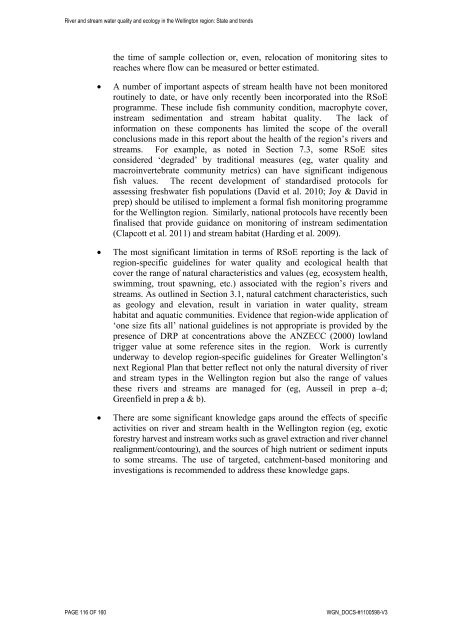River and stream water quality and ecology - Greater Wellington ...
River and stream water quality and ecology - Greater Wellington ...
River and stream water quality and ecology - Greater Wellington ...
You also want an ePaper? Increase the reach of your titles
YUMPU automatically turns print PDFs into web optimized ePapers that Google loves.
<strong>River</strong> <strong>and</strong> <strong>stream</strong> <strong>water</strong> <strong>quality</strong> <strong>and</strong> <strong>ecology</strong> in the <strong>Wellington</strong> region: State <strong>and</strong> trends<br />
the time of sample collection or, even, relocation of monitoring sites to<br />
reaches where flow can be measured or better estimated.<br />
A number of important aspects of <strong>stream</strong> health have not been monitored<br />
routinely to date, or have only recently been incorporated into the RSoE<br />
programme. These include fish community condition, macrophyte cover,<br />
in<strong>stream</strong> sedimentation <strong>and</strong> <strong>stream</strong> habitat <strong>quality</strong>. The lack of<br />
information on these components has limited the scope of the overall<br />
conclusions made in this report about the health of the region’s rivers <strong>and</strong><br />
<strong>stream</strong>s. For example, as noted in Section 7.3, some RSoE sites<br />
considered ‘degraded’ by traditional measures (eg, <strong>water</strong> <strong>quality</strong> <strong>and</strong><br />
macroinvertebrate community metrics) can have significant indigenous<br />
fish values. The recent development of st<strong>and</strong>ardised protocols for<br />
assessing fresh<strong>water</strong> fish populations (David et al. 2010; Joy & David in<br />
prep) should be utilised to implement a formal fish monitoring programme<br />
for the <strong>Wellington</strong> region. Similarly, national protocols have recently been<br />
finalised that provide guidance on monitoring of in<strong>stream</strong> sedimentation<br />
(Clapcott et al. 2011) <strong>and</strong> <strong>stream</strong> habitat (Harding et al. 2009).<br />
The most significant limitation in terms of RSoE reporting is the lack of<br />
region-specific guidelines for <strong>water</strong> <strong>quality</strong> <strong>and</strong> ecological health that<br />
cover the range of natural characteristics <strong>and</strong> values (eg, ecosystem health,<br />
swimming, trout spawning, etc.) associated with the region’s rivers <strong>and</strong><br />
<strong>stream</strong>s. As outlined in Section 3.1, natural catchment characteristics, such<br />
as geology <strong>and</strong> elevation, result in variation in <strong>water</strong> <strong>quality</strong>, <strong>stream</strong><br />
habitat <strong>and</strong> aquatic communities. Evidence that region-wide application of<br />
‘one size fits all’ national guidelines is not appropriate is provided by the<br />
presence of DRP at concentrations above the ANZECC (2000) lowl<strong>and</strong><br />
trigger value at some reference sites in the region. Work is currently<br />
underway to develop region-specific guidelines for <strong>Greater</strong> <strong>Wellington</strong>’s<br />
next Regional Plan that better reflect not only the natural diversity of river<br />
<strong>and</strong> <strong>stream</strong> types in the <strong>Wellington</strong> region but also the range of values<br />
these rivers <strong>and</strong> <strong>stream</strong>s are managed for (eg, Ausseil in prep a–d;<br />
Greenfield in prep a & b).<br />
There are some significant knowledge gaps around the effects of specific<br />
activities on river <strong>and</strong> <strong>stream</strong> health in the <strong>Wellington</strong> region (eg, exotic<br />
forestry harvest <strong>and</strong> in<strong>stream</strong> works such as gravel extraction <strong>and</strong> river channel<br />
realignment/contouring), <strong>and</strong> the sources of high nutrient or sediment inputs<br />
to some <strong>stream</strong>s. The use of targeted, catchment-based monitoring <strong>and</strong><br />
investigations is recommended to address these knowledge gaps.<br />
PAGE 116 OF 160 WGN_DOCS-#1100598-V3
















